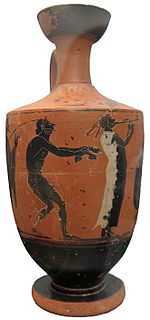Acheloos Painter
| Acheloos Painter | |
|---|---|
|
Athlete bringing jumping weights into play; that is, actually jumping, and an aulos player, theme on a black-figure lekythos by the Acheloos Painter. The vase is located in the Staatliche Antikensammlungen, Inventory Number 1892, Berlin. | |
| Born |
Unknown. The name vase is a black-figure amphora depicting Herakles fighting the river god, Acheloos. Before 525 BCE |
| Died | About 500 BCE |
| Nationality | Greek |
| Known for | Vase painting |
| Notable work | Worked at Athens |
| Movement | Black-figure style, Leagros Group. |
The Acheloos Painter, active around 525 - 500 BCE in Athens, was a vase painter of the black-figure style. His scenes were like those of the Leagros Group; however, unlike their work, his themes are comic episodes, not unlike modern cartoons. Herakles was a favorite topic, as were banqueting scenes. His banqueters were portrayed satirically: overweight, aging, huge, jutting noses, and so on. The heroic is made anti-heroic by parody. His preferred vase forms are amporae and hydriae.[1]
Name vase
He received his name from a representation of a fight between the river god, Acheloos, and Heracles, on formerly Amphora F 1851 in the Berlin Antique collection,[2] now missing.[1] In this comic depiction, the screaming and frightened river god, in the form of a horned centaur, is being kept from escaping by an unflustered Herakles pulling him back by the horns. Hermes, stock messenger of the gods, sits at ease. His long, projecting beard juts out parallel to his long, projecting nose. In the heroic scenes of Greek mythology, a hero ought to be victorious over awful and implacable monsters according the will of the divine gods. In this scene and others like it the hero demeans himself with a craven and ridiculous monster while the caricature of divinity slumps over in a state of ennui.[3] "Nonsense inscriptions" have nothing to say.
In an unrelated scene on the opposite side, a hoplite and an archer say goodbye to their aged parents. The wrinkles are shown in the mother's neck. The hoplite's shield covers him up to his nose. On it is emblazoned an isolated running leg with a naked buttock. A dog sniffs at the hoplite's groin region.
Select works
| Name | Images | Dimensions | Type | Date | Description | Museum Record |
| Altenburg, Staatliches Lindenau-Museum | ||||||
| Amphora 228 | ||||||
| Basel, Antikenmuseum und Sammlung Ludwig | ||||||
| Amphora BS 1906.294 | ||||||
| Berlin, Antikensammlung | ||||||
| Amphora F 1845 | ||||||
| Amphora F 1851 | ||||||
| Hydria F 1905 | ||||||
| Cambridge, Harvard University Art Museums | ||||||
| Amphora 1960.314 | H. 40.9 cm, W. 27.9 cm | Attic Black-figure neck amphora | 510-500 BC | A: Departure scene | Record | |
| Florence, Museo archeologico di Firenze | ||||||
| Amphora 3871 | | Attic black-figure amphora | 510-500 BC | A: Heracles and the cercopi; B: Heracles and Apollo | ||
| London, The British Museum | ||||||
| Panathenaic Amphora B 167 | ||||||
| Mississippi, University of Mississippi | ||||||
| Amphora 1977.3.71 | H. 36 cm, D. 24.5 cm | Attic black-figure amphora | 510-500 BC | Departure scene | record | |
| Munich, Staatliche Antikensammlung | ||||||
| Amphora SL 459 | ||||||
| Lekythos 1892 |  | ---- | Attic black-figure lekythos | 525-500 BC | Athlete holding jumping weights and aulos player | |
| New York, Metropolitan Museum of Art | ||||||
| Pelike 49.11.1 |  | H. 33.3 cm | Attic black figure pelike | c.510 BC | A: King Midas's men discover Silenos; B: Flute-player and boxers | Record |
| Reading, The Ure Museum of Greek Archaeology | ||||||
| Amphora 45.10.22 | ||||||
| Toledo, Toledo Museum of Art | ||||||
| Amphora 58.69 | ||||||
| Würzburg, Martin von Wagner Museum | ||||||
| Amphora 210 | ||||||
Notes
- ↑ 1.0 1.1 Campbell, Gordon, ed. (2007). "Acheloos Painter". The Grove Encyclopedia of Classical Art and Architecture. Volume I: Abacus – Lyson and Kallikles Tomb. New York: Oxford University Press.
untraced; ex-Berlin
- ↑ "Berlin F 1851 (Vase)". Art & Archaeology Artifact Browser, Perseus Digital Library. Tufts University. Retrieved 30 June 2012.
- ↑ Cohen, Beth (2000). Not the classical ideal: Athens and the construction of the other in Greek art. Leiden; Boston: Brill. p. 86.
Additional references
- Beazley, J D (1986). The development of Attic black-figure. Sather classical lectures, v. 24. Berkeley: University of California Press. p. 79.
External links
| Wikimedia Commons has media related to Acheloos Painter. |
- "3 Vases whose Painter is Acheloos Painter". Art & Archaeology Artifact Browser, Perseus Digital Library. Tufts University. Retrieved 20 June 2012.
| ||||||||||||||||||||||||||||||||||||||||||||||||||